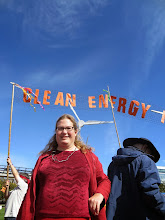Want to quadruple the potential market for solar in Virginia? The
answer is to open up the benefits of solar ownership to renters, people
with shaded roofs, and others who can’t install solar panels on their
own property. Several legislators have been working with the solar
industry to take a step in that direction this year. Senator Edwards (SB 350) and Delegates Krupicka (HB 906) and Yost (HB 879)
introduced bills that would allow residents of multi-family housing
communities like condominiums to band together to purchase a solar
system, with all the participants able to claim a credit on their
utility bills for their share of the energy generated.
Virginia’s utilities don’t want to see this happen. When people
install solar systems, they buy less power from their utility, which
otherwise has a monopoly on the generation and sale of electricity.
Now Dominion Virginia Power thinks it has figured out a way to hijack
the bills. It proposes to scrap the community net metering language
that’s in there now and substitute language that would give the utility
the exclusive right to build and own community systems and sell the
power to the customers.
Read more: http://powerforthepeopleva.com/2014/01/28/dominions-plan-to-hijack-community-net-metering/
Originally published on Women in Cleantech and Sustainability
Where can you find a solar community with a shared mission, shared information, and shared resources — without even leaving your home or office? All that and more are packed into one quick hour a month at #SolarChat, a virtual networking opportunity hosted by Raina Russo.
#SolarChat is a Tweetup, or a Meetup conducted virtually over Twitter. I wasn’t sure what to expect when I attended my first #SolarChat in October 2012. What I found was a fun and exciting place to exchange ideas and information with solar enthusiasts everywhere — and even a place to meet new people.
Two years since its founding in November 2011, #SolarChat has become the cool party that everyone wants to get into. And all are welcome. This cool party consistently trends on Twitter, generating over 1500 tweets and an average of 4.5 million impressions each time.




